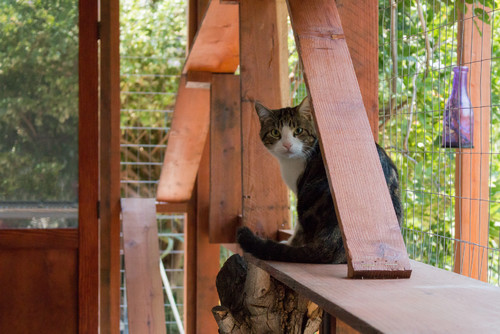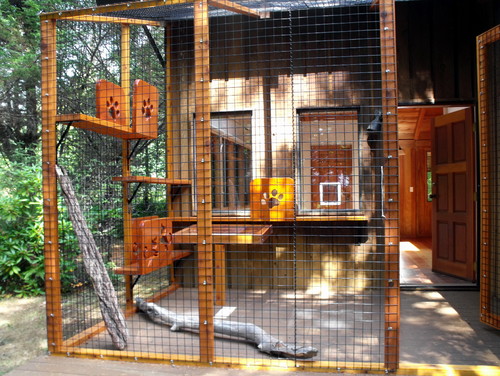×
Email
HOW CAN WE HELP?
6a - 7p Monday - Friday
6a - 2p Saturday
Mountain Time
PHONE
1-877-738-7237
FAX
1-866-777-1434
MAIL
Pets Best
2323 S Vista Ave. Ste. 100
Boise, ID 83705
My Question
First Name
Last Name
Policy (optional)
Phone
Best Day
Best Time
Click here to text customer care
- Pet Insurance
- Blog
- How to Build a Safe and Stylish Catio

It's the dilemma of every cat owner: how to let Kitty enjoy the outdoors without risk of the Great Escape. The outside world can be a dangerous place for a roaming cat, with the threat of predators, cars, poison and diseases. Not to mention the danger to wild birds, which outdoor cats kill in monumental numbers. Catios -- or cat patios -- are safely enclosed playhouses for felines that provide fresh air, mental stimulation and exercise.
Cats confined indoors are at higher risk for stress-related diseases, says Dr. Martine van Boeijen, a cat veterinarian in Perth, Australia. "An enclosed catio, which safely confines your cat to your property, allows your cat to have the best of both worlds." Here is a basic guide on custom, kit and DIY options for adding a catio to your home.
Catios can be as elaborate as a custom-designed feline jungle gym or as simple as enclosing a patio with screening. Here, Rasputin enjoys one of the perches in a custom catio built in Arcadia, California.
Related: Browse More Patio Projects
Suggested Features
It's important to make sure catios are escape-proof and include basic feline comforts:
- Entry door or window, or walkway or tunnel from the house
- Perches, ramps, steps, bridges, catwalks
- Post or tree for scratching and climbing
- Hiding places
- Beds, pillows or hammocks for resting
- Fresh drinking water
- Shady areas and fans for cooling; heating pad for cold weather
- Predator-proof screening, especially if the home is near wildlands with coyotes, cougars or bobcats
- Roof or covering to protect from elements
By Julie Sheer - See more Home Design Photos
Some Assembly Required: Catio Kits
For those who don't want to design a catio themselves, there are companies that sell pre-designed catio kits, design plans or individual components. If you're very handy with a hammer, you can build it yourself, or you can hire a carpenter. Some companies can recommend installers. Custom builder John Creviston warns that the price of a kit may seem reasonable, but costs rise when you add shipping and hire someone to install it.
Portable playspace. Catio Spaces, based in Seattle, sells DIY plans for four catio designs, ranging from a window box to a four-sided enclosure with a tunnel. Each design plan has a downloadable PDF that includes a materials list, tools list and step-by-step instructions "that take the guesswork out of building a catio," company founder Cynthia Chomos says. Shown above is the Sanctuary style, with the wood frame painted black. Chomos says her plans call for four-by-four pressure-treated horizontal wood frames with panels that screw on. The panels break down so they can be dismantled at a future date.
By Julie Sheer - See more Home Design Photos
Ready for kickoff. Chomos -- a general contractor and feng shui consultant -- also builds catios for clients in the Seattle area, using a two-person carpentry crew. She decorated the interior of this Seattle Seahawks football team-themed catio for a diehard fan. She says it "combines a 'man cave' and catio for human and feline enjoyment."
By Julie Sheer - See more Home Design Photos
See them yourself. Catio tours are now a thing. Chomos' catios have been featured on a catio tour that visits 10 catios in the greater Seattle area.
Other catio tours take place in Portland, Oregon, and Santa Cruz, California. The tours are usually sponsored in part by animal welfare groups and are meant to inform and educate the public about keeping cats and wildlife safe.
Other Catio Kit Companies
Habitat Haven in Toronto sells pre-designed kits with all the parts included and also individual components such as stairs, towers, tunnels and bridges that fit together so you can design and build one yourself.
Catio Designs sells DIY design plans that include the Luxor self-standing model; the Ritz, which is accessed via a door; Windows on the World, entered through a window; and the Petite Window, which extends out from a window like a greenhouse.
For the Skilled DIYer
Although it's best to have a pro build a catio if you're not skilled at carpentry, an experienced DIYer could tackle the project.
Here, kitty, kitty, kitty ... The catio shown here was part of the renovation of a 1920s bungalow in South Carolina. Owners Aimee and Greg Talbot, who own an antiques company called EuroLuxHome,wanted to create a special space for their seven cats -- including Minkey and Fozzy, shown at left lounging on their perches at sunset.
Aimee feeds the cats on the platforms and keeps the litter boxes in the catio. "That keeps all the mess of the sand and food outside, and then I can just sweep and hose it all down periodically."
By Julie Sheer - See more Home Design Photos
The couple screened in an existing 11-by-17-foot porch, built walkways, steps, corner platforms and a sisal rope firefighter's pole for the cats to climb on and use as a scratching post. They tiled the screened-in porch themselves with Mexican tile and used a vintage door, which they found at the Antique Tobacco Barn in Asheville, North Carolina.
Fozzy surveys the scene from the highest cat shelf in the catio. Tip: DIY catio builders should first consider their home's layout and sun orientation when designing a catio, Greg Reid of Plan A Architecture says. "Then try to create a structure that looks integrated with the house, and be sure to add elements that are beneficial to your cats." The cats are supplied with cat grass, which they graze on all day, Aimee says. The couple installed two cat doors on either side of the front door. With multiple cats, she recommends installing several access doors since cats tend to be territorial. "We didn't want one cat to hog the porch by not letting the others out the door," she says.
This article is part of a collaboration between Pets Best pet health insurance and Houzz. We’ve teamed up to provide you this series of articles focused on pets and homes. Learn more about pet insurance at petsbest.com.





